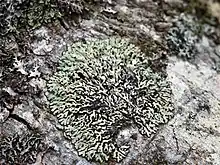| Menegazzia terebrata | |
|---|---|
 | |
| Menegazzia terebrata, photographed in Bavaria | |
| Scientific classification | |
| Domain: | Eukaryota |
| Kingdom: | Fungi |
| Division: | Ascomycota |
| Class: | Lecanoromycetes |
| Order: | Lecanorales |
| Family: | Parmeliaceae |
| Genus: | Menegazzia |
| Species: | M. terebrata |
| Binomial name | |
| Menegazzia terebrata | |
| Synonyms | |
|
Species synonymy
| |
Menegazzia terebrata is a species of foliose lichen found scattered across many continents, including North America, South America, Europe, Africa, and Asia.[1][2]
Taxonomy
This species was first described as Lobaria terebrata by Georg Franz Hoffmann in 1796. In 1854, Italian lichenologist Abramo Bartolommeo Massalongo renamed it Menegazzia terebrata.
Description
Menegazzia terebrata has a glossy blue-grey thallus and a black, wrinkled undersurface. This species does not have any rhizines on the undersurface. The medulla is white. Asci contain eight single-celled ascospores, like most species of Ascomycota. The spores are amyloid positive. The outside edges are different shades of brown. This species is distinguished by small holes in the upper thallus. Apothecia are rarely seen on this species so they mostly reproduce asexually. The lobes of this lichen are rounded and almost tube-like, with soredia on the lobe tips.[1][2] The holes in its upper surface give the lichen many of its common names, including treeflute lichen, honeycomb lichen, and keyhole lichen.[1][3] A potassium hydroxide test will produce K+ yellow results on the surface and medulla of this lichen.[1]
Habitat and distribution
Menegazzia terebrata grows on acidic substrates, including trees and rock. It prefers acidic species of tree, including Alder, Beech, and Northern white cedar.[3] It also prefers to grow on more acidic siliceous and siliciferous rock.[2] It is most common in northern wet-mesic forests.[3][4] It can be an indicator of an old growth forest.[1][5] This species sometimes grows with moss, and often the moss grows between the lobes of lichen.[6] It is often found growing on coastlines near the ocean.[7] Menegazzia terebrata was found to be an indicator species of clean air in Western Oregon and Washington.[8]
Ecology
The algae in this lichen are chlorococcoid.[1]
Chemistry
Menegazzia terebrata produces a number of secondary metabolites. The cortex contains atranorin.[1][2][9] The medullar layer contains menegazziaic acid, stictic acid and constictic acid.[2][1] Menegazzia terebrata and another species of lichen in the Menegazzia family were the first two species where menegazziaic acid were found, so it was named after them.[10][9] Meneggazziaic acid is a 3-hydroxylated 3-deformylstitic acid.[10]
See also
References
- 1 2 3 4 5 6 7 8 "Honeycomb Lichen (Menegazzia terebrata) - JungleDragon". www.jungledragon.com. Retrieved 2022-05-08.
- 1 2 3 4 5 "LIAS light - Item Descriptions". liaslight.lias.net. Retrieved 2022-05-08.
- 1 2 3 "Treeflute (Menegazzia terebrata) - Wisconsin DNR". dnr.wi.gov. Retrieved 2022-05-08.
- ↑ Mae., Leuthner, Shirley. Lichen distribution in Oregon coastal dune communities. OCLC 18208259.
{{cite book}}: CS1 maint: multiple names: authors list (link) - ↑ Matwiejuk, Anna (2018-01-24). "New and noteworthy species of lichens from the Augustów Forest (northeastern Poland)". Acta Mycologica. 52 (2). doi:10.5586/am.1102. ISSN 2353-074X.
- ↑ Bjerke, Jarle W.; Obermayer, Walter (2005-11-01). "The genus Menegazzia (Parmeliaceae, lichenized Ascomycetes) in the Tibetan region". Nova Hedwigia. 81 (3–4): 301–310. doi:10.1127/0029-5035/2005/0081-0301. ISSN 0029-5035.
- ↑ GAUSLAA, Yngvar (January 2014). "Rain, dew, and humid air as drivers of morphology, function and spatial distribution in epiphytic lichens". The Lichenologist. 46 (1): 1–16. doi:10.1017/s0024282913000753. ISSN 0024-2829.
- ↑ Geiser, Linda H.; Neitlich, Peter N. (January 2007). "Air pollution and climate gradients in western Oregon and Washington indicated by epiphytic macrolichens". Environmental Pollution. 145 (1): 203–218. doi:10.1016/j.envpol.2006.03.024. ISSN 0269-7491.
- 1 2 Hirayama, Teruhisa; Fujikawa, Fukujiro; Yosioka, Itiro; Kitagawa, Isao (1976). "On the constituents of the lichen in the genus Menegazzia. Menegazziaic acid, a new depsidone from Menegazzia asahinae (Yas. ex Zahlbr.) Sant. and Menegazzia terebrata (Hoffm.) Mass". Chemical and Pharmaceutical Bulletin. 24 (10): 2340–2344. doi:10.1248/cpb.24.2340. ISSN 0009-2363.
- 1 2 Culberson, Chicita F.; Culberson, William Louis; Johnson, Anita (1981). "A Standardized TLC Analysis of β-Orcinol Depsidones". The Bryologist. 84 (1): 16. doi:10.2307/3242974. ISSN 0007-2745.